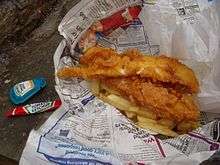Disposable food packaging
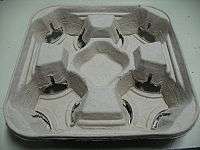
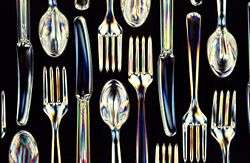
Disposable food packaging comprises disposable items often found in fast food restaurants, takeout restaurants and kiosks, and catering establishments. Food serving items for picnics and parties are very similar. Typical disposable foodservice products are foam food containers, plates, bowls, cups, utensils, doilies and tray papers. These products can be made from a number of materials including plastics, paper, bioresins and bamboo.
Packaging of fast food and take-out food is necessary for the customer but involves a significant amount of material that ends up in landfill, recycling, composting, or litter.[1]
History
The paper plate was invented by the German bookbinder Hermann Henschel in Luckenwalde in 1867.
In 1908, Samuel J. Crumbine[2] was a public health officer in Kansas. He was on a train when he witnessed one of his tuberculosis patients taking a drink of water from a common dipper and water bucket (a publicly shared way of drinking water) in the car. Right behind his patient was a young girl who drank from the same dipper and bucket. This inspired him to launch a crusade to ban publicly shared or common utensils in public places. Taking note of the trend, Lawrence Luellen and Hugh Moore invented a disposable paper cup called the "Health Cup" and later renamed the "Dixie Cup".[3][4]
Single-use cone cups were followed by the commercialization of single-use plates and bowls, wooden cutlery, and paper food wraps. By the 1930s these products were widely used to feed the men and women who worked on the remote dams, bridges and roads of the Works Progress Administration. In the 1940s they were used to feed defense factory workers.[5]
After World War II, foodservice packaging materials like plastic and polystyrene foam were developed. The unique properties of these materials (insulation and weight reduction) and their ability to be made into a variety of shapes and sizes, provided foodservice operators, and consumers, with a wider variety of packaging choices.[5]
A major development in disposable foodservice packaging happened in 1948 when the newly founded McDonald's restaurant closed to revamp its menu. Along with changing their menu items, the restaurant wanted to change the way it handled dishwashing and dishwashers, car hops and wait staff, and storage, breakage and (customer) theft of table ware. When the McDonald's re-opened six months later, its meals were no longer served with the use of glasses, plates or cutlery, and were taken away from the restaurant by the customers.[5]
Sanitation
The use of disposable foodservice packaging is a step toward preventing foodborne disease. By being used only once, these products significantly reduce food contamination and the spread of diseases.[6]
The U.S. Food and Drug Administration’s Food Code authoritatively spells out the sanitary and health advantages of single-use foodservice packaging in specific situations: "A food establishment without facilities...for cleaning and sanitizing kitchenware and tableware shall provide only single-use kitchenware, single-service articles, and single-use articles for use by food employees and single-service articles for use by consumers." The Food Code further states "in situations in which the reuse of multiuse items could result in foodborne illness to consumers, single-service and single-use articles must be used to ensure safety."[6]
Materials
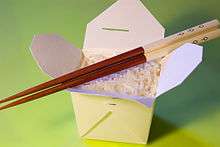
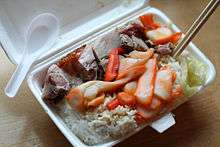
Disposable foodservice packaging can be made from a number of materials, each with its own uses and benefits.
Aluminum
Aluminum is used to manufacture foils, wraps, bags, containers, and trays.
Plastics
Many disposable foodservice products can be made of plastic or plastic-coated paper: cups, plates, bowls, trays, food containers and cutlery, for example. Plastics are used because the material is lightweight and holds the temperature of hot/cold food and beverages. Foamed polystyrene (sometimes referred to as Styrofoam) is in one of the most common types of plastics used for foodservice packaging, in the form of the foam food container. Non-foamed polystyrene is sometimes also used for utensils or plastic plates. Polyethylene and other plastics are also used.
Plastic wrap is sometimes used to cover a tray of food.
Many plastics are marked with the SPI recycling codes for identification.
Paper and paperboard
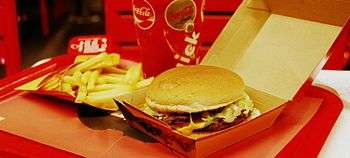
Disposable foodservice products made from paper, paperboard, and corrugated fiberboard: including cups, plates, bowls, napkins, carryout bags, trays, egg cartons, doilies and tray liners. Some paper products are coated - mostly with plastic - or treated to improve wet strength or grease resistance. Paper and paperboard packaging like pizza trays, French fry trays, Chinese noodle soup boxes, hamburger clamshell trays, etc., are developed by printers utilizing paper converting equipment such as tray formers.
Molded pulp products are made from recycled newsprint and are formed under heat and pressure into plates, bowls, trays and cup carriers. Molded pulp is readily recyclable.
Alternative materials
A number of manufacturers are now making disposable foodservice products from a combination of natural starches, recycled fibers, water, air, and natural minerals.[7] These composite products include cups, plates, bowls, cutlery, sandwich wraps, food containers and trays. Ideally these products are easily biodegradable and composted after use.
The material used to make these kinds of disposable foodservice products is primarily PLA or polylactic acid. Some products are made from a mixture of PLA and pulp fibers that are molded into disposable foodservice items with heat and pressure. Others are made from a composite or mixture of starch and other materials, such as limestone and recycled fibers, to give them additional strength.[7]
In India, the dry fallen leaves of the Areca catechu palm (betel tree) are collected and hot-pressed into disposable palm leaf plates and bowls.
Cost
By reducing the need for equipment and additional labor, disposable foodservice packaging is an economical alternative to multiuse items and eliminates the need for dishwashers and other support equipment (racks, carts, dollies, shelving, bins) It can also save money on water and energy used by dishwashers and can eliminate the need to replace reusables that are broken, damaged, stolen or accidentally discarded.[8]
Other Economics
Disposable tableware was a key part of the business strategy of chain fast food restaurants in the US. In order for the business model to work, fast food chains, notably McDonald's, had to convince consumers[9] through advertising campaigns to carry their own tableware to a waste bins, in order to avoid labor expenses incurred in clearing tables. By establishing a custom in which customers are encouraged to carry disposables, some of the internal costs of the disposable tableware can be offset.
Environmental concerns

Comparison with washable foodservice products
According to the U.S. Environmental Protection Agency, paper and plastic foodservice packaging discarded in the country’s municipal solid waste stream accounted 1.3 percent in 2007 (by weight) of municipal solid waste.[10] The U.S. Environmental Protection Agency also says that an often-cited waste prevention measure is the use of washable plates, cups, napkins instead of the disposables variety.
While this will reduce solid waste, it will have other environmental effects, such as increased water and energy use. Overall, reusable dishware – even if only offered to customers for on-site use – is considered to be the best environmental choice.[11]
Cost of recycling
Collection costs, the value of scrap material, and increased energy expenditures create an additional economic barrier to recycling foodservice packaging. While recycling foodservice packaging is difficult, recycled materials are being used in some foodservice packaging.
Environmental footprint
Many people are working on reducing the environmental footprint of packaging for food service. Often a Life-cycle assessment is valuable to determine the effects throughout the entire system. Some actions include:
- Packaging of incoming food and supplies can work towards the broad sustainable packaging guidelines offered by many organizations. This includes the recycling of packaging generated within the restaurant.
- Packaging products used by the restaurant can include specified amounts of recycled content in the products.
- Many packaging products can be compostable, but care is needed to match the needs of regional composting facilities. Sometimes products can be certified [12] to meet international standards such as ASTM International D6400, ASTM D6868, and EN 13432.[13]
- Some single-use food packaging is recyclable but food contamination of products is often a problem for recyclers.[14]
Illusion of recycling and "recyclable" claims
Disposible product manufacturers frequently include "recyclable" or "please recycle" indicia on their products; however the availability and effectiveness of such recycling campaigns is limited.[15] A common approach of restaurants featuring disposable tableware is to label one or more of their waste bins as "recycling", although realistically, the amount of washing required for effective recycling would make such "recycling" unrealistic.[16][17] In addition to greenwashing, these approaches are intended to encourage consumers to bus disposable tableware.
See also
Notes
- ↑ Reducing Wasted Food & Packaging: A Guide for Food Services and Restaurants (PDF), EPA-909-K-14-002, US Environmental Protection Agency, archived from the original (PDF) on 18 March 2015, retrieved 9 March 2015
- ↑ "Samuel J. Crumbine - Kansapedia - Kansas Historical Society". KsHS.org. Retrieved 4 April 2017.
- ↑ "Dixie Cup Company History". Lafayette College Libraries. August 1995. Retrieved 5 October 2011.
- ↑ Food and Drink Quarterly, Vol 4 Issue 4, "Package Perfect" By John Burke
- 1 2 3 Foodservice Packaging Institute, "A Brief History of Foodservice Packaging", 2006
- 1 2 "US FDA/CFSAN FDA Food Code". FoodSafety.gov. October 5, 2007. Archived from the original on March 27, 2009. Retrieved March 23, 2009.
- 1 2 Foodservice Packaging Institute, "Single-Use Foodservice Packaging: A Tutorial", 2007
- ↑ Library Archived February 14, 2009, at the Wayback Machine.
- ↑ http://skoozeme.com/issues/dontbus.html
- ↑ EPA,OSWER,ORCR, US. "Advancing Sustainable Materials Management: Facts and Figures". EPA.gov. Retrieved 4 April 2017.
- ↑ "Disposable Cups, Cutlery and Dishware". Resource Guide, Sustainability at work. City of Portland. 2014. Retrieved 2017-08-31.
- ↑ "Biodegradable Products Institute - Certified Compostable". BPIWorld.org. Retrieved 4 April 2017.
- ↑ Dietz, C (February 2013), Compostable Products for Food Services (PDF), Eco-Cycle
- ↑ Raymond J. Ehrlich (2007). "Plastics Foodservice Packaging Group : Economic Realities of Recycling". Archived from the original on 2009-01-11. Retrieved 23 March 2009.
- ↑ Environmental Ineffectiveness, Millennium Alliance for Humanity and Biosphere (MAHB)
- ↑ Because You Asked: Why Can’t I Recycle Stuff with Food On It?, recyclebank.com
- ↑ How Clean Must Food Containers Be Before Recycling?, Mother Jones
